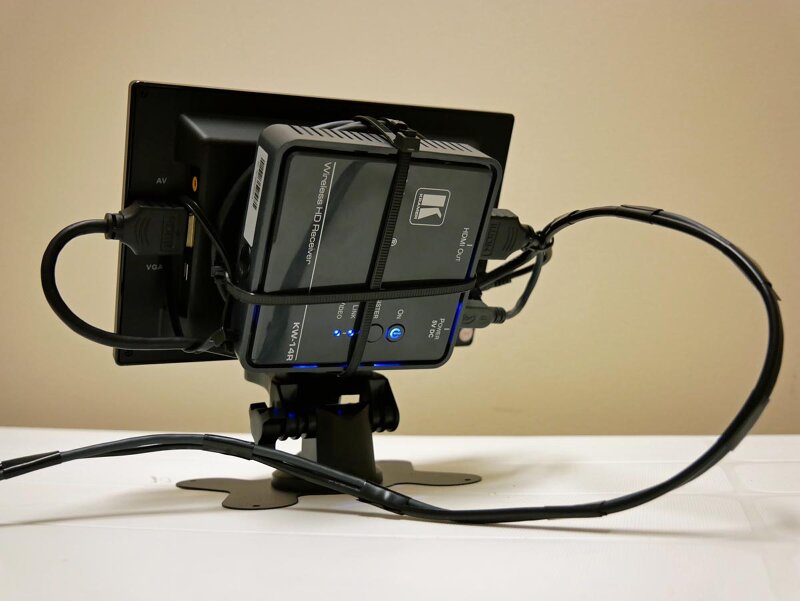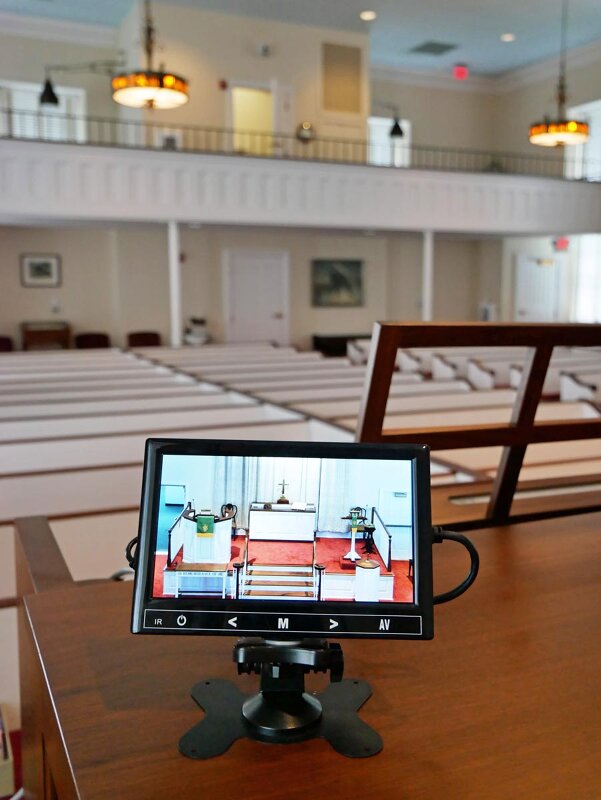As the COVID-19 outbreak grew in size back in March, a small local church contacted me and asked if there was a way to shoot video of each Sunday’s service and post it to the church’s Web site, instead of having live services. The small congregation is mostly made up of members age 50 and older, and many are immune system-compromised and (understandably) terrified of catching the coronavirus.

Accordingly, I began recording video and audio of a sermon, prayers, and occasionally communion, two days before the service date. I edited the video and audio and posted it to YouTube, and the church’s Webmaster subsequently links that video to the church Web site and its Facebook page. Everything is captured as 720p HD video and finished at that resolution to preserve streaming bandwidth.
About a month ago, I decided to start live streaming of services and purchased a PTZ camera and an HDMI-to-USB capture card. HDBaseT extenders transport the video from the camera, mounted at the back of the choir loft in the 1837-vintage sanctuary, about 200’ (60m) to the church offices in a newer building, where everything ties into a Verizon FiOS connection.
The PTZ camera comes with a standard TV remote and the ability to store and recall ten different combinations of pan, tilt, and zoom settings. I chose this method so that anyone could easily operate the camera during a service (not just me) and cover all of the required camera angles. The problem that remained was how an operator could see and verify that the PTZ camera had responded each time to a command. I decided a small video monitor would do the trick – but how to connect it away from the choir loft?
Digging Around the Basement
Digging into my basement workshop shelves, I found a Kramer KW-14 wireless HDMI transmitter/receiver pair that I had used during InfoComm and client training programs. These products use links in the 5 GHz UNII band and apply some compression to the video and audio signals, bonding 20 MHz channels to transport signals with surprisingly low latency.

I found a 7” LCD monitor online at Amazon, located a short HDMI jumper cable, and fashioned a 5-volt USB power supply for the receiver. The two pieces are held together with cable ties and can be set up anywhere in the sanctuary there are two AC outlets. Given the mostly rural character of the surrounding countryside and the Faraday cage-like interior structure of the building (plaster over wire lathe), I wasn’t concerned about possible interference from nearby WiFi networks.

The entire AV system boots up with one power switch, starting up the house audio system (put in after a 2010 fire mostly leveled the building), the PTZ camera, Kramer TP-590TXR/RXR HDBaseT extenders, and a Magewell HDMI-to-USB capture card. (The system is congregant-proof.) Turning on the 7” monitor and the KW-14 receiver usually results in a successful link-up within 30 seconds – if not, a button on the receiver “registers” the two units and links them together.
Reminiscing about Wireless HDMI
This got me reminiscing about wireless HDMI, a concept I first came across in the early 2000s while visiting Amimon Semiconductor at CES. It seemed pretty cool at the time, although expensive: Long HDMI cables were a lot cheaper than the transmitter/receiver combos, which at one time were being sold for $600 at Best Buy and other retailers under their Rocketfish house brand. Needless to say, wireless HDMI never caught on with consumers. LG and Sony also came out with prototype LCD TVs that had the receiver technology embedded, but these products never made it past concept stage.
Amimon eventually lost interest in the consumer wireless HDMI market and moved into the drone business, selling high-speed wireless SDI links for HD cameras. The company was acquired by Vitec Partners in 2018, and continues to sell wireless HD camera links. But a recent visit to their Web site shows they’re still in the wireless HDMI game, focusing on professional AV applications with their View Link technology. It’s available as a PC board for custom installations, and they also offer a “white label” product (which is what my KW-14 boxes are).
Currently, View Link supports any video resolutions in HDMI 1.3/1.4, which means it tops out at 1080p/60 RGB (4.45 Gb/s uncompressed). For live streaming, I set the camera to 720p output with 8-bit 4:2:0 color, which falls well within the bandwidth specification. And since View Link started out as a consumer product, the wireless video/audio signals are encrypted using RSA and AES algorithms and comply with HDCP 1.3 and 2.2 requirements.
It’s Still Around
For nostalgia’s sake, I checked on the Best Buy Web site while writing this article, and sure enough, there are several models of wireless HDMI links still available. The cheaper models ($140 USD) don’t have a very robust linking system and operate in the 2.4 GHz WiFi band, which is a recipe for disaster in urban installations! The more expensive models ($280 USD) do incorporate the Amimon IP, but there was only one model available at the store – and only one in stock. (Not exactly selling like hot cakes.)
Practically speaking; the growth of streaming and ever-faster broadband connections have obviated the need for wireless HDMI connections – look at the dwindling number of Blu-ray players offered for sale, most of which would be installed a short distance from an Ultra HDTV in any case. Chromecast, Fire TV Stick, and other streaming products plug directly into HDMI ports, so for the average consumer, wireless HDMI doesn’t make any sense today.
But for my installation at the church, it was just the ticket, and looks pretty cool sitting atop the organ housing… (PP)


